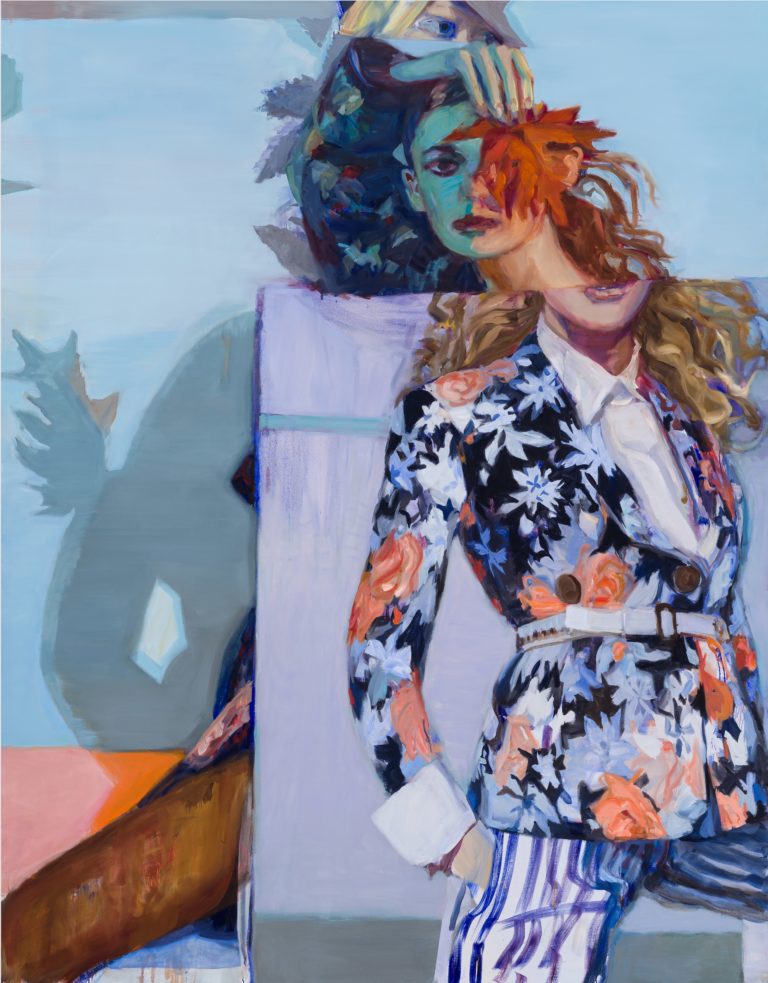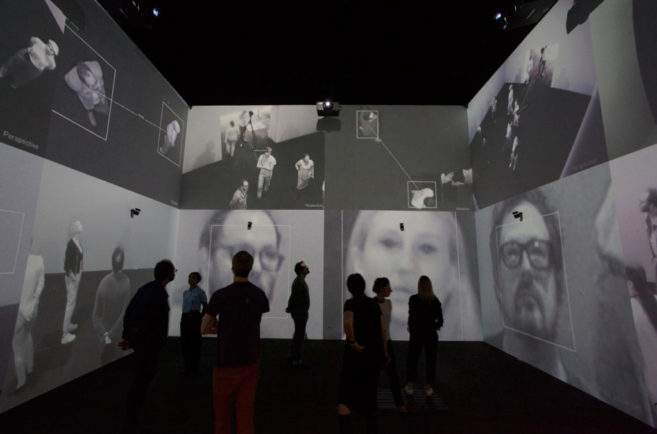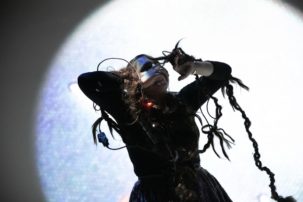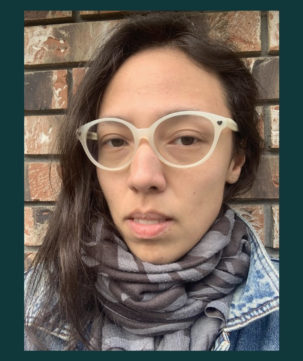 Janet Werner, Beast, 2019.
Oil on canvas, 2.43 x 1.88 m.
Collection Musée d’art contemporain de Montréal;
Purchased with the support of the Collectors Symposium 2019, National Bank Private Banking 1859. Photo: Guy L’Heureux.
Janet Werner, Beast, 2019.
Oil on canvas, 2.43 x 1.88 m.
Collection Musée d’art contemporain de Montréal;
Purchased with the support of the Collectors Symposium 2019, National Bank Private Banking 1859. Photo: Guy L’Heureux.
Janet Werner and I met by chance this spring in Vancouver. I was there on one of my regular art trips from Seattle, where I was living at the time. Werner was artist in residence at Griffin Art Projects, where I guest curated a show a few years ago at the invitation of then-director Lee Plested, who was also responsible for Werner’s stay. During my visit, the new director, Lisa Baldissera, asked if I would like to meet their artist in residence. Janet Werner? I did not know that name. But moments later, Werner was standing before me, and her lush, odd, figurative paintings, I discovered, were entirely familiar. Meeting Janet was like looking in the mirror—or at my sister. Our similar looks and age instantly amused us both, and lead to an easy rapport. Short on time, we agreed to continue our conversation later at the Musée d’art contemporain de Montréal (MACM), where her first major museum show opened earlier this fall.
Why did I find the work familiar? Because we both came of age in SoHo, New York, in the early 1990s, when acerbic figurative painting was gaining momentum and—along with its unlikely counterpart, third-wave feminist art—taking aim at the politics of representation. This pedigree was visible in the way Werner could make paint do anything: gorgeous, scumbled little passages of gestural abstraction; heart-breakingly spare, monochrome scenarios reminiscent of Luc Tuymans (channelling Munch); flagrant surrealism; dreamy pastoral backdrops straight out of a Goya canvas; renderings that swung from deliberately maladroit to the hazy elegance of Bonnard. Her portraits imbued the Kate Mosses and Linda Evangelistas of the time with a psyche and a soul.
Werner falls into a category recently being mined of relevant artists who, whether due to location, social networks or race/ethnicity, landed outside the tight spotlight of the mainstream art world. For women artists older than Werner, gender would have been an impediment too. These are artists who remained in the background even though they participated in and helped shape noted artistic shifts and trends.
In this case, the fanfare centred around New York–area painters such as Elizabeth Peyton, Karen Kilimnik and Werner’s fellow Yale classmates John Currin and Lisa Yuskavage. Meanwhile, Werner left the US for a teaching job in Saskatchewan. Nonetheless, her practice has had an ongoing (if one-way) dialogue with her American peers. Recently Werner has struck new ground with invented yet plausible minimal interiors, often misconstrued as her actual studio. The composite female figures, pieced together from the pages of fashion magazines and brought to life as the subjects of single and group portraits, have been returned to their natural—and de-weaponized—state as so much ephemera that drifts in and out of our lives.
Melissa Feldman: I know that this solo show at the MACM focuses on work from the last 10 years, but could you talk more broadly about your long interest in portraiture?
Janet Werner: The paintings started out as invented figures from imagination without any photographic references. The first ones were very…they had quite a different character. They were all frontal and more flat. I would say they were also more androgynous.
MF: Would I recognize the work as yours? Sometimes earlier work can look very different.
JW: You’d probably recognize it, but it did look very different because it wasn’t done under the influence of photography. Those portraits actually came out of an investigation of abstraction. When I was in school [at Yale] a lot of people in the program were working abstractly, including John Currin.
MF: Why abstraction? Was there an instructor there who influenced you all or was that just the trend at the time?
JW: No, not really. For me, then and now, if the work’s interesting it’s because of the formal abstract qualities.
MF: Well, yes, that’s what I’ve noticed—that the work is very formalist—but what surprises me is how little that’s been addressed in the writing about your work, which tends to focus on imagery and your process of messing with fashion images.
JW: No, it hasn’t been addressed.
MF: Well it’s become unavoidable given the newer work.
JW: This new direction happened at a moment when I wanted to take a break from the portraits after 20 years, even though, you know, I’ve been exploring a lot of different approaches. It was like a straightjacket that I would keep finding my way out of by coming at it from a different angle. And then for some reason around 2016, I don’t know exactly why, I guess maybe getting older partly, I just wanted more. The space has always been important in the portraits even though there’s always a figure and a ground. I just wanted to play with more elements, a bit of architecture and to pull back and to see what else could come in. And in fact, if you saw on the other side of this wall that painting of the table with the three pictures on it [Still Life with Witch (2019)], there’s a witch in the middle. That was the one that really inspired me. I liked what was happening on a miniature scale. It was somewhat more painterly and I liked the idea that something was happening with the paint that was different too…more open.
MF: You mean less tightly painted?
JW: Yeah, less photographic. When you’re working on such a small scale, you can’t make it photographic. I’ve been wrestling with the photograph all along because I don’t like what it signifies and I don’t like how it makes forms.
MF: The photos come from fashion magazines?
JW: Yes, almost all of the paintings begin with images from fashion magazines that I fold in the manner of exquisite corpses. The starting point is still in photographs.
MF: So with the recent works, the Sticky Pictures (2017) series, for example, you have wrestled the photograph down to size. How have these negative feelings about photography manifested in your portraits?
JW: I often have to destroy a portrait when it gets too photographic. I get angry and start undoing the portrait, removing or altering features, messing with the paint, in the process of which something else comes through. The closet expressionist in me comes out and I’m generally much more satisfied with the result. The paint has to move. But with the recent interiors, it’s the space itself that is the invented part, where I’m messing with the paint.
MF: So you are referring to a painting like Green Room (2018)?
JW: Yes. Beast (2019) is another example. It’s the space that’s invented. But the images are…I’m just trying to copy them.
MF: I still feel like we haven’t gotten to the bottom of your fascination with portraiture. And I’m also curious as to how your work—with its cutting and pasting and distorting of images—might relate to or been affected by the shifts in art practices with the rise of digital culture over the past couple of decades.
JW: The earlier portraits were deliberately minimal and plain, unadorned. I thought of them as existential and psychological in nature. But once I began using fashion sources and collage they shifted somewhat to reflect the larger culture. Now I’m very conscious of the proliferation of images and the constant consumption of images that we are all being swept up in. I still think of the portraits as being about subjectivity, though, and they are meant to recuperate an idea of interiority, the idea of an inner world or worlds being manifest through the representations of the body. I believe this complexity removes them from objectified treatments in representations of women in the media and art history.
MF: What about your portraits in which the subject’s face has been obliterated by paint or a mask, or folded out of the picture—and the strong element of theatricality that goes with those images? Maybe I’m not understanding what you mean by “interiority,” but how do you square the shocking appearance with conveying a sense of inner life?
JW: Well, I identify the sense of violence or shock, the obliteration or folding, with metaphors about interior life, life history, trauma or some sort of narrative action that takes place within. They signify some sort of narrative that relates to the projected persona.
MF: I think of us as having come of age during third-wave feminism in the early 1990s—Beverly Semmes, Janine Antoni, the rediscovery of the first-generation feminist artists like Hannah Wilke. It coloured my worldview and my curatorial work—I showed people like Semmes and Karen Kilimnik in the early 1990s when I was curator at ICA in Philadelphia. But, you know, even Kilimnik’s more media-minded work of the ’90s was not motivated by feminism. There’s a lot of social critique going on there, but I don’t think you could just put it in that box of feminism.
JW: Mmm hmm. Who wants to be in that box? I don’t think I’m in that box either. I mean, people sometimes think that because I paint mostly women I’m trying to make some kind of feminist point about women’s relationship to the body. And I’m often asked why I don’t also paint men. But when I started looking at images from media and popular culture, it’s the images of women that interest me the most. It’s partly because that’s what’s there, it’s more available. And it’s partly because I’m a woman. I can relate. And there’s an iconic aspect to a lot of those images, you know, the Hollywood kinds of images.
MF: Yeah.
JW: There’s also something to do with my mother. I don’t know why, but, you know, she’s my icon of femininity.
MF: In what sense? Was she glamorous?
JW: Yeah, she was. She was glamorous. I feel when I see these images in culture and media and fashion, there’s something there that I recognize. We all do, right? It’s built for us to identify with. It really lends itself to both being borrowed from and critiqued.
MF: Yes, borrowed from and critiqued. I also see an element of pleasure. How women and those who female-identify express themselves through fashion. Playing with identity through different looks is fun.
JW: Yeah. Thanks for bringing that up, because I’m losing sight of that lately. I mean, truly, for me, it’s always about fun on some level. I don’t play in real life; I play in the studio. I’m not trying to make a feminist statement, but the work is definitely emerging from a female subjectivity.
MF: I wanted to ask you about that word “subjectivity.” It comes up a lot in the writing about your work. Also “embodiment.” What do we mean by subjectivity? My sense of myself, right?
JW: Yeah, like who you are.
MF: Or who I think I am?
JW: Exactly. But in making the portraits, the fun game is that you can be a lot of other people, not just who you think you are.
MF: That’s like Cindy Sherman, but with her it doesn’t seem to be about self-exploration but rather the representation of women. What about in your work? Do you identify with the identities that you portray?
JW: Yeah. Even the ones that are sadomasochistic. Someone recently asked me about violence and sadomasochism in my work. I was quiet for a while. But I do think about violence in a way with the act of painting and also what I’m doing by folding and interweaving different body parts. For example, in Hass (2017), I blinded the figure; she can’t see. I folded the image so it’s just her mouth and this black mask. And it gives me some kind of perverse pleasure to do that obviously.
MF: But you are not necessarily saying in the painting that this is what the patriarchy and society and the media have done to her.
JW: No, because you could see that as a disempowering, but you can also see that as an empowering thing—that a woman can fold herself up and she can reopen herself.
MF: She can hide…
JW: …And explode. That idea of shock that happens when you do an operation like exquisite corpse. It’s sort of an undeniable awakening.







